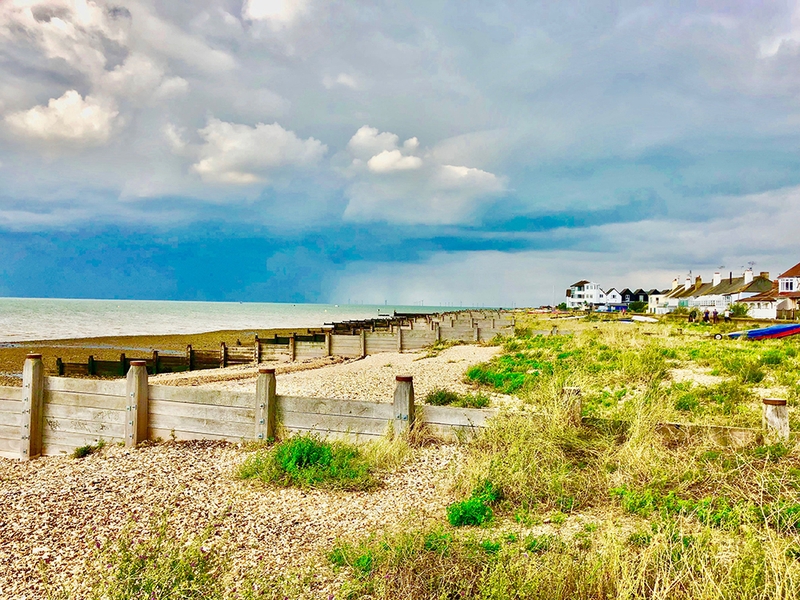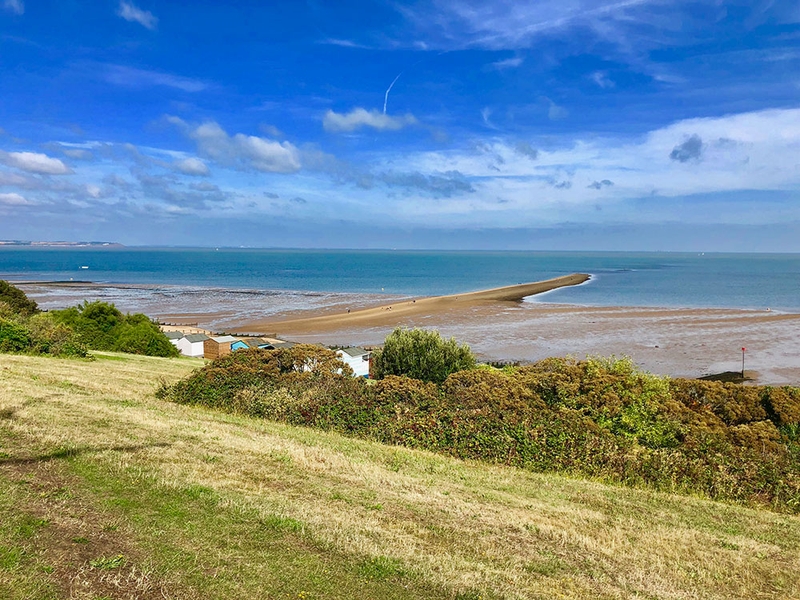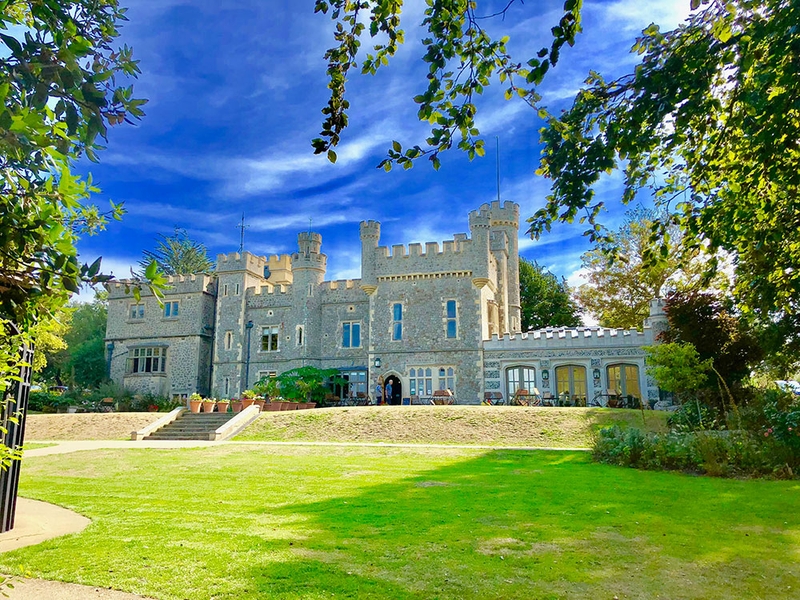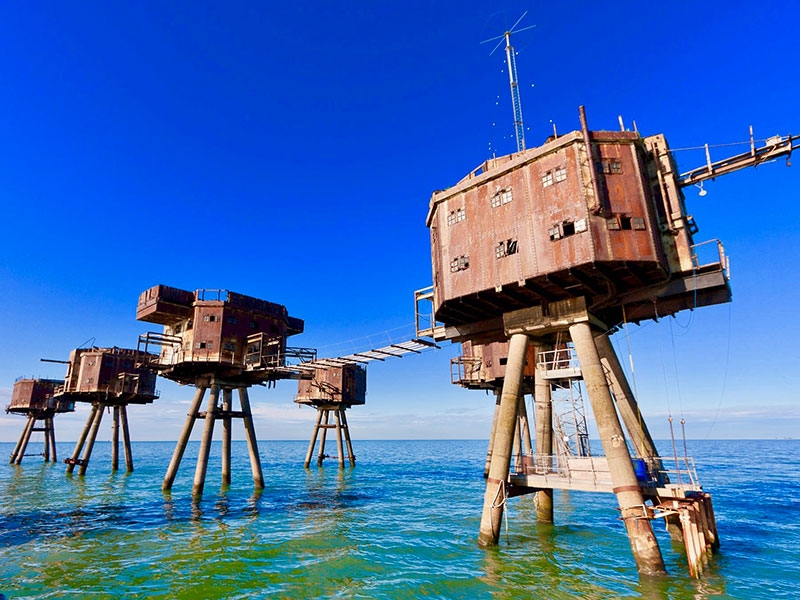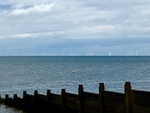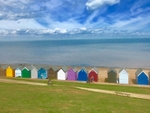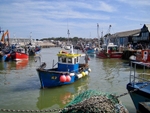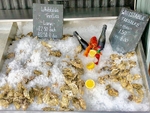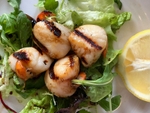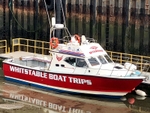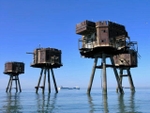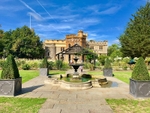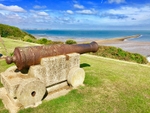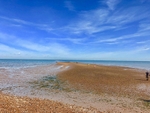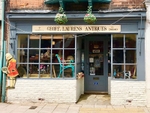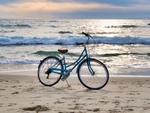1. Seaside Fun
Whitstable’s beaches and clean water are great for seaside fun.
Swimming
Whitstable’s beaches are pebbled and separated by groynes every 40 or so metres to stop erosion . Swimming is a popular activity in summer months. By comparison with other English seaside resorts, the water is pretty warm.
One part of the Whitstable coastline, Tankerton Beach (10 mins walk to the east of the Harbour), is patrolled by lifeguards in the summer months.
Top Tip: Swimming is only really possible two hours each side of high tide. This is because the sea retreats by up to a kilometre at low tide to expose the muddy (though oyster-packed) seabed. Get information about high tide times from the BBC Tide Tables.
Watersports
Whitstable is a popular centre for the usual seaside water sports. Oyster Coast Watersports, found just to the east of the Harbour, hires kayaks and paddleboards by the hour. They also offer a range of Royal Yacht Association sailing and powerboat courses.
The Whitstable beaches are also a popular kite-surfing destination, with easy access and launching (particularly at low and mid-tides). At low tide, there is also lots of flat water (good for cruising and freestyling).
Other activities
A fun activity for children is crabbing (trying to catch crabs using a net containing fish or ham).
Crabbing kits and bait can be bought for under £5 from a variety of shops around the Harbour. You’ll also need a bucket filled with seawater—to hold your crabs before returning them to the water. Make sure you fill it with seawater, change it regularly, and introduce some rocks and seaweed (to recreate the crabs' natural environment and reduce stress).
Finally, take time to check out Whitstable’s iconic pastel-coloured beach huts (pictured).
2. Whitstable's Harbour
Whitstable has a small working harbour that is predominantly used by whelk and oyster fishermen and is home to a number of good eateries.
Fishing
The blue and red fishing boats of the Whitstable fleet will often be seen moored around Whitstable’s Harbour. If you are lucky, you will catch fishermen unloading their catch.
Whelks (large sea snails) are a local speciality. After they are hauled onto dry land they are taken to the whelk processing plant near the Harbour’s entrance: you will be able to see them being poured onto a conveyor belt going into the plant.
Whelks are boiled before the snails are removed from their shells. They are traditionally eaten with vinegar and pepper – why not try one from the nearby stalls and shops?
Eating
A few of the Harbour’s eateries warrant mention:
- the Crab and Winkle Restaurant, overlooking the Harbour, offers great harbour views and the freshest of fish (above the Harbour’s fish supermarket, with a wide variety of mains priced at around £20),
- the Lobster Shack, found at the northern end of the Harbour, boasts great seaviews and a simple but delicious menu with favourites such as fish/scampi and chips and baked lobster with garlic and parsley butter.
Oysters
Whitstable oysters were first discovered by the Romans two millennia ago; they shipped large numbers of them back to Rome. They have been harvested by the Whitstable Oyster Company since the 1400s, with peak production of about 80 million a year being reached in the 1850s (most were shipped to Billingsgate market to feed East London’s growing population).
These days oysters are a luxury delicacy. They can be bought from a variety of locations around Whitstable for around £12-15 per half dozen. We suggest trying out the Whitstable Oyster Company’s Fish Restaurant, to the west of the harbour (left as you face the sea). Other dishes include chargrilled sardines (£9), pan fried local wild seabass fillet with puy lentils and aioli (£24) and whole cooked crab with mayonnaise (£20-£25).
More
Finally, check out Whitstable’s Harbour Village—a series of green huts offering local crafts, food and drink.
3. Boat trips
Boat trips, departing from the Harbour, are offered by three providers.
Whitstable Boat Trips operates from a small cabin to the right-hand side of the Harbour (as you face the sea). They offer three tours in their powerful sunseeker motoryacht. The shortest (20 minutes, £10 pp) is the popular Bay Trip and takes passengers out along the coastline of Whitstable Bay.
Another tour takes passengers to the Swale Estuary to spot seals between Faversham and the Isle of Sheppey. This trip last 60 minutes and costs £30 for adults, or £20 for children under 16.
A higher-adrenaline alternative is to take a speedboat to the Maunsell Sea Forts with Oyster Watersports (1 hour, £40pp). Their 7.8 metre Ribeye is capable of over 40 knots and reaches the Forts in about 15 minutes
An altogether classier experience is offered by Steve Norris, the owner and skipper of the 1892 Greta sailing barge. Greta is the oldest active little ship that took part in the Dunkirk rescue during the early years of the Second World War. Trips are, weather permitting, powered by the wind and take passengers to either the Sea Forts or to the Swale Estuary. Tea and coffee is provided in a below-deck lounge. Trips are for up to 12 people and previously cost £48 during the week and £54 at weekends and on bank holidays. Check the website for the this season's prices and sailing times.
4. Whitstable Castle and Tankerton Slopes
Whitstable Castle, or Tankerton Towers (to give it its original name), is a small castle in immaculate grounds found 10 minutes’ walk from Whitstable Harbour.
Originally constructed in the 1790s, and developed and improved by successive owners in the intervening years, Whitstable Castle is found at the top of the small hill to the east of Whitstable’s harbour (right as you face the sea).
The Castle’s tower is its oldest feature, built of brick and flint, with the adjoining extension wing constructed in Georgian gothic style. The Castle now houses a popular tea room.
But the real attractions here are the stunningly planted gardens. Opposite the Castle’s main entrance is found the rose garden, featuring a large variety of rose species planted around an attractive central fountain.
Don’t forget to take a look at the nearby woodland garden and the impressive regency garden—complete with snaking gravel paths, statues, a gazebo and ornamental beds (with year-round interest created by colourful shrubs, herbaceous perennials and bulbs).
Other attractions include the Tankerton Cove Toddlers Play Space for 3 to 8-year olds and the popular bowling green, used by Whitstable’s lawn bowls club.
Head towards the sea from the Castle’s main entrance and bear right to come to Tankerton Slopes, the town’s best viewpoint, offering stunning vistas down to the multicoloured beach huts that line the promenade and out to the windfarm, sea forts and The Street (described below).
5. The Windfarm, Sea Forts and 'Street'
Kentish Flats Windfarm
The Kentish Flats Windfarm is a wonderful addition to the Whitstable seascape. Located 10 kilometres offshore, the 45 Vestas V90-3MW turbines that make up the farm were installed in 2005 and 2015.
The turbines have a height of 70 metres and a rotor diameter of 90 metres. They are capable of producing almost 140 MWs of electricity – enough to power about 50 million televisions!
The Maunsell Army Sea Forts
A few kilometres further out to sea are found the Maunsell Army Sea Forts. Designed by Guy Maunsell, and built between 1942-3, these forts were used to combat Nazi aircraft seeking to use the Thames to help them fly to London.
There were four sets of army forts in all, one of which--known as the Red Sands fort--is located off Whitstable. The forts each comprise seven towers: a central control tower (also housing accommodation) together with five towers housing guns and a searchlight tower.
Overall, Maunsell’s army forts shot down 22 enemy aircraft and 30 V bombs. They were decommissioned in the 1950s and fell into disuse thereafter—though they have occasionally been squatted in by pirate radio stations.
The Street
The windfarm and forts can be inspected close up by those taking one of the boat rides described above. Failing that, why not walk down ‘The Street’ to get that little bit closer to them.
The Street is a natural shingle sandbank about 1 kilometre long that is exposed during low tide. It is located at the bottom of Tankerton Slopes, ten minutes walk to the east of the Harbour (right as you face the sea). Many people choose to walk it, though you should obviously exercise caution. At high tide the course of The Street can be seen from Tankerton Slopes.
6. Whitstable Town Centre and Museum
Whitstable’s town centre is packed with independent shops.
The town's numerous antique and bric-a-brac shops are a great way to spend a couple hours on a rainy day. Other interesting shops include Peekaboo Kids Boutique, the Fabric Shop, Staines Farm Shop, Granny Smith's greengrocers, the Fish Slab Gallery and Oxford Street Books.
Whitstable’s High Street is also full of great places to eat. Aside from the usual chain restaurants (Prezzo, Zizzi), we suggest Samphire (a bistro specialising in local fish and seasonal veg), Wheelers Oyster Bar (an unpretentious place, serving excellent and innovative food, to which you can bring your own wine ), and Harbour Street Tapas.
Further up the high street is found Whitstable’s small museum. For a nominal entrance fee (£3 for adults; £2 concessions; chidren go free), you can discover Whitstable’s heritage (one of the country’s first steam engine services ran between Canterbury and Whitstable and it was in Whitstable that helmet diving was invented) and its most famous resident, the actor Peter Cushing (of Dr Who and Star Wars fame).
7. Canterbury
Canterbury is a great day trip from Whitstable: you can drive the 7 miles to get here or take the bus (services leave every 15 minutes) or the train.
Canterbury Cathedral
Founded in 602 AD by Saint Augustine, Canterbury Cathedral is one of the UK's most impressive tourist attractions.
Of gothic and Romanesque design, the 172-metre long Cathedral was constructed between 1070 and 1077, though major alterations continued to be made until the 19th century. Its most striking external features are its 72-metre high central tower and two shorter bell and clock towers.
The interior of the Cathedral is notable for stained glass windows (pictured), tall nave, and elaborately decorated crypt.
The Cathedral is best known as the place where the knights of King Henry II brutally murdered Archbishop Thomas Beckett in 1170 after hearing the King exclaim "who will rid me of this turbulent priest." Henry later regretted his actions, publicly repenting at Beckett's tomb five years later.
About 200 years on, Chaucer wrote The Canterbury Tales. Widely regarded as the greatest early English-language work, the book recounts the stories told by 25 colourful pilgrims on their way to the Cathedral.
The Cathedral retains its importance to this day, being the cathedral of the Leader of the Church of England, the Archbishop of Canterbury, and having been granted world heritage status in 1988. Services are conducted at the Cathedral most days.
More things to do in Canterbury
Don’t overlook Canterbury’s other attractions, which include a lengthy cobblestoned and pedestrianised high street (great for shopping and picking up lunch), the Canterbury Roman Museum, which has one of the UK's last remaining in-situ Roman pavement mosaics, and the Beaney House of Art and Knowledge (a small and superbly curated museum with no entrance fee).
8. More things to do in Whitstable
Cycling
Whitstable offers plenty of safe cycling. The easiest option is to ride along the seafront to Herne Bay. The ride will take about 45 minutes and offers great views out to the Kentish Flats windfarm. You'll also pass the Tankerton slopes meadow and the Swalecliffe Brook nature reserve. There's lots to do in Herne Bay: there's an amusement arcade, a great pier complete with carousel and other children's rides, and a number of good eating options.
Other cycling options include the Crab and Winkle Way. This 7-mile route (each way) between Whitstable and Canterbury follows a disused railway path and includes 61 metres of ascent as you leave Canterbury (the middle section is also undulating). A great option for intermediate cyclists on a fine summer's day.
Kent Cycle Hire offers an efficient and moderately priced service (charging £27.60 to hire an adult bike for a day).
The Wildwood wildlife park
A great family option is the Wildwood wildlife park, a 15-minute drive from Whitstable.
The park, run by a charitable organisation, has an outstanding range of animals. They include stags and hinds, adders and grass snakes, otters, badgers, pigs, a variety of owls, lynxes and wildcats, boars, reindeer, wolves and konik horses. But the show is stolen by the brown bears, housed in a large enclosure at the centre of the complex, over which visitors can walk along a rope bridge.
Other attractions include a great area devoted to bees, excellent children's playgrounds (one for under 5s, another for older children), and a wind turbine. There is a cafe, though we didn't find the food particularly healthy.
Prices are £13.64 without a 10% voluntary donation for adults and £10.91 for over 3s. Check out Wildwood's website for opening times.
Wingham Wildlife Park
The Wingham Wildlife Park is another fantastic option for kids. Located about 30 minutes from Whitstable, this is a mid-sized zoo.
Residents include tigers, pelicans, flamingos, meercats, a range of snakes, penguins, moon bears and much more. There are also super indoor and outdoor children's play areas and good food options.
The highlight for youngsters is, however, likely to be the dinosaur park: with moving, life-sized models of scores of dinosaurs including the T-Rex, Diplodocus, Triceritos and Spinosaurus.
Entry is not cheap (£19 for adults and £16 for children aged between 2 and 15 when tickets are bought in advance online). However, Wingham provides a really full day out. Highly recommended.
